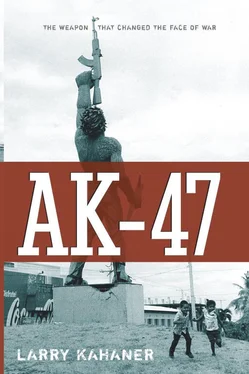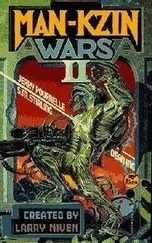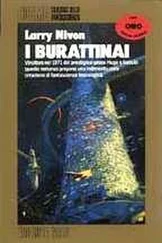Larry Kahaner - AK-47
Здесь есть возможность читать онлайн «Larry Kahaner - AK-47» весь текст электронной книги совершенно бесплатно (целиком полную версию без сокращений). В некоторых случаях можно слушать аудио, скачать через торрент в формате fb2 и присутствует краткое содержание. Город: Hoboken, Год выпуска: 2007, ISBN: 2007, Издательство: John Wiley & Sons, Inc., Жанр: История, military_history, на английском языке. Описание произведения, (предисловие) а так же отзывы посетителей доступны на портале библиотеки ЛибКат.
- Название:AK-47
- Автор:
- Издательство:John Wiley & Sons, Inc.
- Жанр:
- Год:2007
- Город:Hoboken
- ISBN:9780470315668
- Рейтинг книги:3 / 5. Голосов: 1
-
Избранное:Добавить в избранное
- Отзывы:
-
Ваша оценка:
- 60
- 1
- 2
- 3
- 4
- 5
AK-47: краткое содержание, описание и аннотация
Предлагаем к чтению аннотацию, описание, краткое содержание или предисловие (зависит от того, что написал сам автор книги «AK-47»). Если вы не нашли необходимую информацию о книге — напишите в комментариях, мы постараемся отыскать её.
AK-47 — читать онлайн бесплатно полную книгу (весь текст) целиком
Ниже представлен текст книги, разбитый по страницам. Система сохранения места последней прочитанной страницы, позволяет с удобством читать онлайн бесплатно книгу «AK-47», без необходимости каждый раз заново искать на чём Вы остановились. Поставьте закладку, и сможете в любой момент перейти на страницу, на которой закончили чтение.
Интервал:
Закладка:
Some U.S. gun makers were furious with the proposed purchases, saying that it not only demeaned the M-16 but that tax-payer money should not be going overseas at a time when the war was expected to cost in excess of $80 billion annually. Buying AKs for the Iraqi army also prevented them from being synchronized with U.S. weapons, an important issue for joint maneuvers.
Coalition Provisional Authority officials made strong arguments, however, for their purchase. “For better or worse, the AK-47 is the weapon of choice in that part of the world,” said Walter Slocombe, senior advisor to the CPA. “It turns out that every Iraqi male above the age of 12 can take them apart and put them together blindfolded and is a pretty good shot.”
Another reason, and perhaps more important, was value. AKs could be bought for around $60 each in these quantities, while M-16s cost $500 to $600 apiece. Still, it was never made clear why the AKs had to be bought when hundreds of thousands of unused weapons were being uncovered throughout the country.
Even the Russians were angry. Officials of Rosoboronexport expressed frustration that the United States would buy non-Russian AKs from other countries, a move tantamount to aiding piracy, they said. They claimed that no other country had a license to make the AK, and that the U.S. purchase encouraged continued violations. (This was not entirely true. The former Soviet Union had licensed production to Warsaw Pact countries and China and North Korea. This controversy will be discussed later.) “We would like to inform everybody in the world that many countries, including the United States, have unfortunately violated recognized norms,” said Igor Sevaastyanov, head of a Rosoboronexport division.
The story took an even stranger turn when the contract was finally awarded and slated for May 2005 delivery. The contract went to International Trading Establishment, a Jordanian conglomerate that received a $174.4 million deal for all sorts of weaponry including communications gear and night vision equipment in addition to AKs.
One of the subcontractors was China-based Poly Technologies, one of the world’s largest munitions manufacturers. For its part, Poly received $29 million for various weapons, including almost 15,000 AKs, 2,300 light and heavy machine guns, and 72 million rounds of ammunition.
Poly Technologies had a checkered past, however. Officials of the company, which operated under the name Dynasty Holdings of Atlanta, had been indicted in May 1996 for attempting to smuggle 2,000 AKs into the United States along with 4,000, thirty- to forty-round magazines. The U.S. district attorney for the Northern District of California estimated the street value at more than $4 million and said the weapons were headed for street gangs. The weapons had markings from China (NORINCO) and Korea.
The arrests and indictment of fourteen people from NORINCO, Poly, and independent companies followed a sixteen-month investigation during which U.S. agents paid more than $700,000 for 2,000 AKs that were smuggled aboard the ship Empress Phoenix , owned by the China Ocean Shipping Company. Several of those involved pleaded guilty and at the time of writing are awaiting sentence. Others had not yet been charged and one official, Bao Ping Ma, listed in the indictment as president of Dynasty, fled to China and is still considered a fugitive, according to the U.S. government. Dynasty’s Beijing account received 38 percent of the down payment and a portion of the final payment. U.S. Army officials noted that they had done a background investigation on Poly Technologies but not Dynasty Holdings, because the company no longer existed.
As attacks on U.S. troops in Iraq increased, the army was paying closer attention to the importance of the AKs wielded by insurgents. On several occasions, U.S. troops instituted weapons buyback programs to try to eliminate the large number of arms in the streets. During an eight-day period in May 2004, for example, U.S. troops distributed $350,000 daily for everything from pistols to surface-to-air missiles in Sadr City’s Shiite district. They collected nearly 4,000 AKs, at $125 each, 9,000 mortar rounds, other assorted weapons, and ammunition, paying out a total of more than $1.3 million for the period.
Even though one less gun on the streets was considered a victory, the program barely made a dent in the country’s overall supply. Because Iraqis were not required to turn in weapons, many decided to keep them. Also, by law, Iraqi families were permitted to own one registered gun (although many owned multiple unregistered guns), usually an AK kept for personal protection. Citizens were allowed one thirty-round magazine as well. Again, many had multiple magazines. Additionally, as happens in buyback programs, not just in Iraq but other countries as well, people brought in several older arms and used the money to buy a single better model on the black market. Black-market prices of AKs varied during the buyback programs, and U.S. troops adjusted their payment accordingly to stay just above the going rate on the street.
In another bow to the AK’s widespread popularity, U.S. troops began systematic and official training on AKs to familiarize themselves with the weapon they would be encountering most often—both in enemy hands and in the hands of Iraqi soldiers who often patrolled side by side with American troops. Although special operations troops had always been trained on a number of foreign weapons, regular troops now were practicing with AKs both in Iraq and at stateside facilities like Quantico.
Marines who participated in “fam fire” practices were generally not impressed by the AK’s looks. Compared to their own M-16s, the Kalashnikovs were crudely finished, heavy, and inaccurate. When they had the opportunity to fire them, though, they understood the effectiveness at close range of these “bullet hoses.” Like their Soviet counterparts of the cold war, the marines learned to take apart the AK and put it back together in less than thirty seconds.
As civilian contractors working for security companies entered Iraq, they too were trained to fire AKs, and many were issued these weapons by their companies instead of Western arms. The AK’s automatic fire was better suited to non-soldiers who did not have intensive training time or gun skills. It was also ideal for civilians in non-security jobs who wanted an easy-to-fire gun for protection while traveling to their worksites.
As U.S. troops became acclimated to street warfare, their opponents made more and more use of IEDs, homemade devices rigged to explode with a timer or by cell phone command. The charges were often made from explosive materials taken from large pieces of ammunition like mortars.
A favorite tactic of the guerrilla fighters was to place an IED in the path of a Humvee or other unarmored vehicle, and when troops stopped to check the vehicle’s condition, they would find themselves facing a barrage of AK fire. This was reminiscent of similar mujahideen tactics against Soviet soldiers in Afghanistan. In many cases, the GIs would win the firefight but still lose soldiers. This tactic worked especially well against civilian employees traveling in convoys that were not heavily armed. Even though it was not particularly effective in terms of killing large numbers of coalition forces, it eroded troop morale and made soldiers edgy and suspicious of all Iraqi civilians. This in turn sometimes led to rougher handling of civilians at checkpoints and on the street—sometimes humiliating innocent Iraqis in the process—which played into the hands of insurgents looking to turn everyday Iraqis against U.S. forces.
With the continuing violence in Iraq, media reports focused on troops killed by IEDs. While these instances were dramatic, an army report made public in spring 2005 concluded that the most deadly threat to U.S. troops, Iraqis, and civilian contractors was small arms, mainly AKs and machine guns, and not roadside IEDs. The report noted, “Firing small arms in close combat remains the number one casualty-producing tactic.” The report added that Iraqi militia often patrolled in unarmored vehicles, like pickup trucks, and were particularly vulnerable to ambush tactics that stopped a convoy either with bombs or road debris, then sprayed the occupants with automatic fire. By the middle of 2005, insurgents had turned their focus away from U.S. soldiers and trained their sights on Iraqi civilians. One particular group, physicians, were targeted by insurgents to prevent medical care of Iraqis and further cripple the country’s infrastructure. In addition, criminals regularly attacked medical centers, because surgical supplies and medicines brought high prices on the black market. Since the fall of Baghdad, twenty-five doctors had been murdered and three hundred kidnapped. For their protection, the Health Ministry directed physicians to carry AKs along with their stethoscopes.
Читать дальшеИнтервал:
Закладка:
Похожие книги на «AK-47»
Представляем Вашему вниманию похожие книги на «AK-47» списком для выбора. Мы отобрали схожую по названию и смыслу литературу в надежде предоставить читателям больше вариантов отыскать новые, интересные, ещё непрочитанные произведения.
Обсуждение, отзывы о книге «AK-47» и просто собственные мнения читателей. Оставьте ваши комментарии, напишите, что Вы думаете о произведении, его смысле или главных героях. Укажите что конкретно понравилось, а что нет, и почему Вы так считаете.











